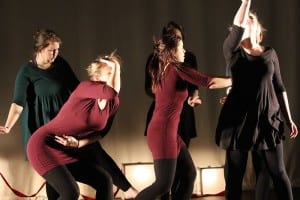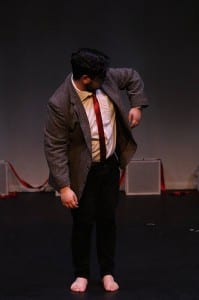“Costume is so important for an actor. It absolutely helps to get into character; it’s the closest thing to you, it touches you. Some actors like to go into make-up and then put their clothes on, but I like to dress first; that’s my routine” (Howarth, 2012).
In ‘The Man Whose Memories Fell Out’ costume is purposefully understated and enough to complement the staging and the story.
With the performance heavily consisting of physical theatre, the costumes needed to allow the performers to move freely within the space, bearing no restrictions to the choreography. When costume was discussed amongst the production team we realised as a group we wanted it to be ‘neutral’ so not to detract the audience’s attention from the physicality of the performance. With the choreography being the primary device in translating the story across to the audience, essentially costume and set design needed to be subtle in order not to distract audiences from the narrative. In terms of contemporary theatre, we are performers, not actors and this was to be interpreted through the costume choice.
In choosing costume that suited and complimented the content and reflected our work as an ensemble, I knew I wanted the female’s costumes to entail a common thread throughout, yet still be able to distinguish them as individuals, through incorporating different colours. I went for black leggings and three styles of dresses; smock, swing and bodycon in various colours to suggest the different characterisations of the wife. Although the only difference between these costumes was the style of dress and the colour, I was able to display a sense of uniform and collaboration between the different representations of the wife. One way me and my co-designer overcame presenting the character of the wife was through the motif of clipping the hair up. Rather than present this literally we wanted it to be done in a precise and fluent manner that came across as part of the performance rather than to break away from it.

In terms of the costume for Michael Cahill who plays the identifiable character of The Man himself, I wanted to suggest elements of naturalism through him wearing minimal clothing to represent him as a ‘function as a mobile piece of scenery connected to life’ (Pavis and Shants, 1998, 81). I felt putting him in a white shirt, black trousers, red tie and tweed blazer indicated a sense of belief that he is just as close to real life as your average working man. However by standing out amongst the rest of the cast, he is granted with a great level of importance as a character, allowing for the audience to instantly recognise him as The Man in which the title states. Dressing him so formal indicates a level of intelligence and as the story unravels we discover this is true through his talent of playing music, regardless of his condition. My choice of a red tie was solely to fit to with the aesthetic of the set of draped red ribbon and red chairs.

Frantic Assembly is a physical theatre company and also a huge influence of ours in terms of inspiration for our choreography. As Scott Graham argues:
“Performers are often asked to move with freedom and dynamism and costume must never impair or limit this. Nor should it pre-empt this by being obviously prepared for movement.” (Frantic Assembly, 2013)
For ‘The Man Whose Memories Fell Out’ I made the point of wanting costume that would not distract the performers with having to fix things back in place or fiddling with accessories, as we are all constantly on stage and in the view of the audience at all times.
Documents
Costume for The Man Whose Memories Fell Out
Costume Cost Spreadsheet for FITB
Works Cited:
Crow, P. (2015) The Man Whose Memories Fell Out [Taken] 20th May.
Graham, S. (2013) Frantic Assembly Forum: Costume Design. [online] London: Frantic Assembly. Available from: http://www.franticassembly.co.uk/forum/topic/55/ [Accessed 9 May 2014].
Howarth, P. (2012) Gary Oldman interview: Dressing the part. [online] London: The Daily Telegraph. Available from:http://fashion.telegraph.co.uk/news-features/TMG9188999/Gary-Oldman-interview-Dressing-the-part.html [Accessed 9 May 2014].
Pavis, P. And Shantz, C. (1998) Dictionary of the Theatre: Terms, Concepts and Analysis. Toronto: University of Toronto Press.